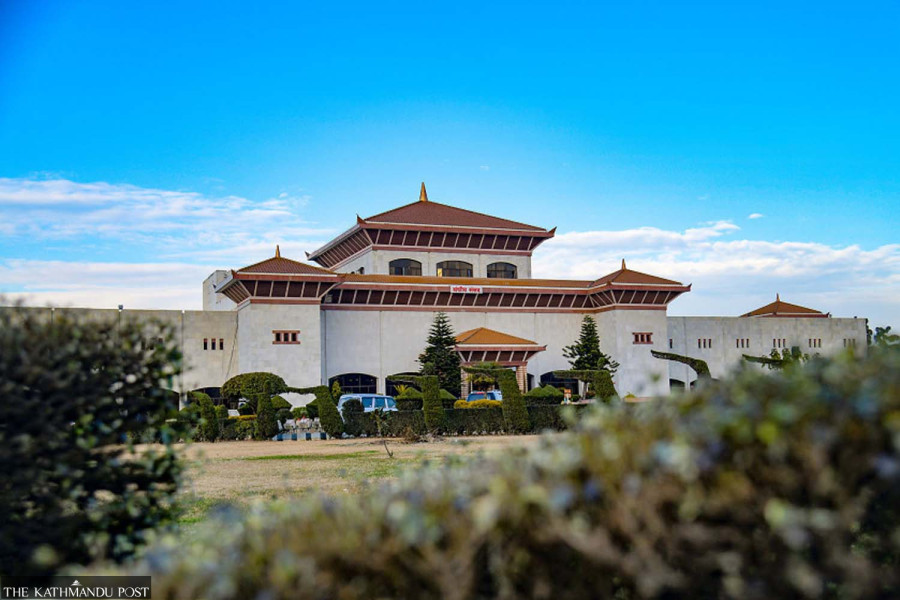National
Constituencies to keep an eye on in November elections
Shifting party loyalties could result in some of the closest races in Nepal’s poll history.
Nishan Khatiwada
With two or more prominent leaders from different parties throwing their hats in the ring, several constituencies are expected to see tough competitions in the November polls.
In most such constituencies, the vote differences between the pivotal candidates will be minimal if the May local elections are any guide.
The CPN-UML has already sealed an electoral deal with the Madhesh-based outfit Janata Samajbadi Party Nepal. Likewise, the pro-monarchy Rastriya Prajatantra Party has also partnered with the UML in some constituencies.
On the other hand, the Nepali Congress-led alliance includes the Maoist Centre, the Unified Socialist and the Rastriya Janamorcha. The Loktantrik Samajbadi Party, the other key Madheshi outfit, is also on the board after it secured a deal with the ruling alliance.
The political arithmetic has changed since the last major elections five years ago. The communist alliance between the UML and the Maoist Centre formed in 2017 has ruptured and the UML is split with the Madhav Nepal faction last year launching the CPN (Unified Socialist).
With major elections just over a month away, all eyes are on some constituencies that are most likely to witness neck-and-neck competition between key actors.
In Jhapa-3, Nepali Congress leader Krishna Prasad Sitaula is pitted against Rastriya Prajatantra Party chair Rajendra Lingden and the competition is going to be tough if May’s local elections and 2017 election results are anything to go by.
In the 2017 federal elections, Lingden, who had the backing of the UML-Maoist Centre alliance, had won with 44,614 votes against Sitaula who got 31,159 votes.
This time, the RPP and the UML have forged a poll partnership, while Sitaula has the backing of the Maoist Centre. The alliance of the RPP and the UML is ahead of the opposition by more than 7,000 votes in Jhapa-3 with the metric of votes these parties obtained in the 2022 local ward chair elections.
For Sitaula, votes from the Maoist Centre will help him give a fierce competition to the previous winner Lingden. As for Lingden, he needs to pull in the maximum number of UML votes to increase his odds of winning.
While Sitaula has a stronger partner in the Maoist Centre, Lingden has elevated his own profile by defeating the then party president Kamal Thapa to win the organisation’s top post last year.
Likewise, in Gulmi-1, UML deputy general secretary Pradeep Gyawali and Nepali Congress leader Chandra Bhandari are in the fray. Gyawali won against Bhandari by a margin of 7,500 with support from the Maoist Centre in 2017. The Maoist Centre this time is contesting the polls under the Congress-led alliance.
An analysis of May’s local election results for ward chairs shows the Nepali Congress, the Unified Socialist, the Maoist Centre and the Janamorcha together had gained a total of 38,354 votes in Gulmi-1. On the other hand, the UML garnered 35,701 votes, which clearly hints at an interesting competition this time. Both Gyawali and Bhandari have strong connections with the voters in the constituency.
Another competitive constituency is Gulmi-2. UML Secretary Gokarna Bista, who had won the previous two elections, is now contesting against Unified Socialist Secretary Ram Kumari Jhakri. In the last elections, Bista had won against Chandra Bahadur KC from Nepali Congress. Jhakri is contesting direct election for the first time.
Jhakri has support of the Nepali Congress, the Maoist Centre and the Rastriya Janamorcha. As Jhakri is a candidate from the Unified Socialist—a party formed after the split with the UML—she could struggle to wrest away the traditional Congress and Maoist votes.
The last local elections results also indicate a tough competition in the constituency.
As per the last local election results of ward chairs, the Nepali Congress, the Maoist Centre, the Unified Socialist and the Rastriya Janamorcha together have 32,487 votes in Gulmi-2 while the UML alone has 30,649 votes.
Similarly, Lamjung could also see an interesting contest in November.
In the district, two senior leaders—UML deputy general secretary Prithivi Subba Gurung and Maoist Centre General Secretary Dev Gurung—are contesting. Gurung won the 2017 elections with the UML support as a common candidate of the communist alliance against Nepali Congress candidate Dil Bahadur Gharti, with a margin of around 9,000 votes.
The difference of the total votes of the Congress-led alliance and the UML is small in the constituency. In the last local elections the alliance got 42,314 votes while the UML bagged 40,197 votes.
Syangja-2 is another constituency that is likely to witness a fierce competition between UML Secretary Padma Aryal and Nepali Congress Vice President Dhan Raj Gurung. In 2017, Aryal emerged winner against Gopal Man Shrestha of the Congress with a margin of around 3,500 votes as a candidate of the left alliance. She has defeated Shrestha, who was elected from the constituency, multiple times since 1990,
Aryal is facing an influential leader of the Nepali Congress in November.
The Congress-led alliance including the Maoist Centre and the Unified Socialist is leading the UML in the constituency by around 2,000 votes, according to the recent local election results for ward chairs. But even the Maoist Centre and the Unified Socialist together do not have a considerable number of votes in the constituency, the results show.
Another competitive race is Kathmandu-5, with UML Senior Vice-chair Ishwar Pokharel and Congress leader Pradip Paudel in the fray in the constituency. Pokharel won the previous federal election from the same constituency while Paudel had lost the provincial election from Tanahun.
Paudel, a former president of the Congress student wing, has a large number of youth followers and with many against repeating old faces, he can garner a good number of youth votes.
Paudel is contesting with the backing of the Maoist Centre and Unified Socialist while the UML is fighting single-handedly in the constituency.
UML got 19,703 votes while the Nepali Congress, the Maoist Centre and the Unified Socialist combined collected 17,848 votes in the constituency in the local elections in May.
Similarly, Nepal Congress central committee member Mohan Basnet lost the 2017 federal elections to Agni Sapkota in Sindhupalchok. Basnet is in the fray from Sindhupalchok-2 this time against UML leader Sher Bahadur Tamang, who had won the 2017 elections against Pashupati Shamsher Rana from the same district.
In the ward chairs’ elections in May, the UML got 31,777 votes, the Nepali Congress secured 29,302 votes, the Maoist Centre got 16,079 votes, the Rastriya Prajatantra Party 5,932 votes and the Unified Socialist secured 1,663 votes in Sindhupalchok-2.
The UML is contesting the elections single-handedly in the constituency while the Congress has the backing of the Maoist Centre and the Unified Socialist. As Basnet has to compete against the winner of the earlier election, the competition is expected to be tough.
Rastriya Prajatantra Party leader Dipak Bohora had lost to Ghanshyam Bhusal in Rupandehi-3 in the 2017 federal polls while the incumbent Home Minister Bal Krishna Khand was elected to Parliament under the proportional representation system. Nepali Congress had supported Bohora in the polls back then. Now, Khand and Bohora are competing against each other in Rupandehi-3.
The current alliance of the UML, the Rastriya Prajatantra Party and the Janata Samajbadi Party had bagged a total of 48,628 votes in Rupandehi-3 if we calculate the votes secured by the ward chairs in the May local polls. The Nepali Congress-led alliance, on the other hand, got 40,388 votes. As Bohora—an influential local leader—is competing against the incumbent home minister, a tough competition is expected.
Likewise, the contest in Arghakhanchi could be mighty close. Congress leader Pushpa Bhusal and UML leader Top Bahadur Rayamajhi, who defected to the party from the Maoist Centre, are competing against each other in the only constituency of the district. Rayamajhi had won the last major polls from Arghakhanchi as a common candidate of the communist alliance with a wide margin of 18,444 votes.
In the 2022 ward chair elections, the Congress, the Maoist Centre, the Unified Socialist, and the Janamorcha combined got 4,542 more votes than the UML in the constituency.
In Makawanpur-1, the ruling alliance has fielded Congress Joint General Secretary Mahalaxmi Upadhyaya (Dina) while the Rastriya Prajatantra Party Nepal Chair Kamal Thapa is contesting the election with the UML’s election symbol.
In 2017, Upadhyaya had lost to the candidate of the communist alliance Birodh Khatiwada with a margin of around 12,ooo votes in Makawanpur-2. On the other hand, Thapa had lost to the common candidate of the communist alliance in Makawanpur-1.
Thapa is in a bid to win the election under UML’s election symbol as UML alone had got 38,056 votes in the last local election for ward chairs.
However, it's easier said than done for Thapa as the Congress, the Maoist Centre and the Unified Socialist combined had garnered 53,297 votes in May, again suggesting a tough competition.




 19.12°C Kathmandu
19.12°C Kathmandu

%20(1).jpg&w=200&height=120)













